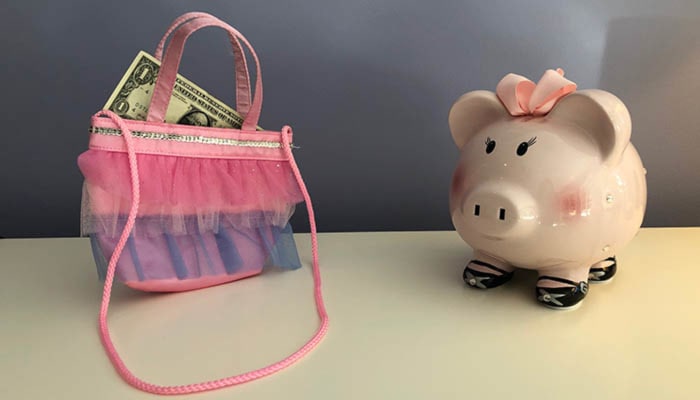By Guest Blogger Tracy Clark, Head of Marketing at Parsec Financial
My daughter recently turned four and my parents gave her a purse with four dollars in it. Two, they told her, were to buy anything she wanted. Another dollar was to save in her piggy bank and the last was to give away to someone who needed it. She quickly bought an ice cream cone at our local pool and put a crumpled-up dollar in her piggy bank. We have yet to give one dollar away but it’s on our to-do list.
This exercise helped reinforce some basic money management principles for my daughter, similar to how I was raised. My father started a private wealth management company Parsec Financial in 1980. I was born in 1985 and I had an investment account and savings account before I could walk. Instead of getting a monthly allowance, I would take my monthly check that I received from dividends from my stock portfolio and deposit that check into my savings account. Little did I realize then what a valuable lesson that was, to understand the difficulty of prioritizing a never-ending list of “must-haves” on a fluctuating income stream!
Now that I’m a parent (I have a 4-year-old and 9-month-old), my husband and I are having conversations around creating some financial groundwork to instill good financial principles and set our children up for success. I’ll be the first to admit it’s difficult as we tend to say ‘yes’ more than we say ‘no.’ Just this past month she got a light-up wand from Paw Patrol and another one from the Dixie Classic Fair. And she already has two others at home. You’ve uncovered my weak spot.

So here are my young family’s two financial priorities at the moment. I hope you find it useful in your own household:
- Consider setting up a 529 plan for your children.
My 2020 resolution is to set up 529 plans for both of my daughters. A 529 plan is a vehicle run by the state which offers basic investment options (much like your 401(k)). You can gift up to $15,000 per year per spouse to each child’s account without gift taxes ($30,000 per couple to each child) until the account balance reaches $300,000+, depending on the state.
Visit www.savingforcollege.com to review state options for 529 plans. You can participate in any state’s 529 plan, but there may be tax benefits and incentives for participating in your state’s plan. The 2017 Tax Cuts and Jobs Act now also allows up to $10,000 per year to be distributed for private K-12 education costs.
Contributing early and often can help you reap the benefits of compounding interest. So, the sooner you start, the better that outcome could be. Typically, an investor invests more heavily in equities when their child is young and moves to more moderate investments as they age. Consult with your financial advisor about the best way to invest for your specific situation.
- Consider opening investment portfolios and making it a family exercise on how to invest.
Each birthday and Christmas we are buying one stock for each child. Currently we make the decision on which company to buy, but we will tell our 4-year-old what company it is and why it makes sense for her, such as the company that creates her beloved princesses, the bank where her grandmother worked her entire career, etc. Eventually we’d love for her to point out products that she likes and ask about the company behind them and suggest that she be a shareholder (wouldn’t that make us so proud!) As my parents joke, when I was 10 at Denny’s I asked the waitress for a specific brand of ketchup over another because I owned stock in that company. (I can only imagine the eye roll I received as she walked away!)
My brother and I recently created a website called “Young and Not Broke” for our friends and peers in their 20s and 30s who are just getting started in saving and investing. I invite you to check it out and learn more financial fundamentals written in a way where hopefully you won’t fall asleep (as we know financial topics can sometimes be a snooze!).
And, if you are wondering, I’ll likely give away some of those light-up wands in addition to the $1 to reinforce the importance of charitable giving. Wish me luck that my preschooler understands this concept and agrees to “let it go!”
 Parsec Financial is a registered fee-only financial advisory firm with $2.7 billion in assets under management as of June 30, 2019. Parsec provides investment management and financial planning to individuals, ERISA consulting and employee education for employer-sponsored retirement plans, tax planning and trust services. Founded in Asheville in 1980 by Bart Boyer, Parsec now serves more than 1,600 individuals and businesses in six offices across North Carolina. To read more, click here.
Parsec Financial is a registered fee-only financial advisory firm with $2.7 billion in assets under management as of June 30, 2019. Parsec provides investment management and financial planning to individuals, ERISA consulting and employee education for employer-sponsored retirement plans, tax planning and trust services. Founded in Asheville in 1980 by Bart Boyer, Parsec now serves more than 1,600 individuals and businesses in six offices across North Carolina. To read more, click here.
- Sponsored by Parsec Financial

















Tracy—I LOVE this!! I am a huge 529 Plan investor. In fact, for about 10 years now I always give our state’s 529 packet as a baby shower gift. I attach $50 check made out to our state’s plan, the minimum to open an account for baby Smith or Jones, or if I know the name. Of course I am left explaining to all the other guests exactly what this is and what and why I am doing this. I explain that once opened, the minimum contribution is only $25! It is a perfect gift for a child who does not need a 17th Barbie Doll ( or princess wand!). Usually all the future aunties, grandmas, other relatives and friends are all there and everyone agrees the kids do not need more toys! I have had folks thank me later for the “529 College Seminar” I have plugged at the kid’s shower!